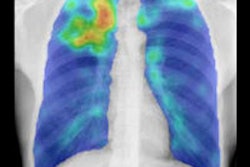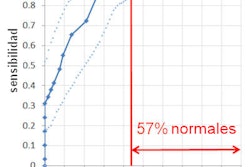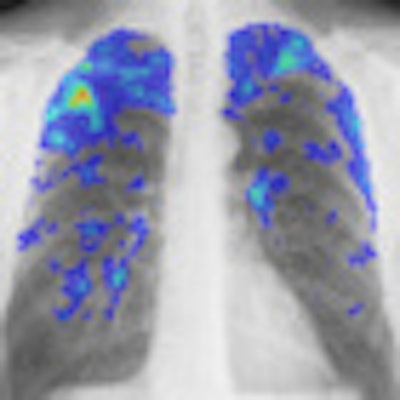
Computer-aided detection (CAD) software can be used during tuberculosis (TB) screening to triage those at high-risk of having the disease, potentially decreasing the image-reading burden on screening programs, according to research from Radboud University Nijmegen Medical Center in the Netherlands.
In a preliminary study that evaluated the performance of a CAD prototype on cases from a U.K. TB screening program, the Dutch team found that CAD could allow nearly 60% of cases to be prescreened as normal without having to be interpreted by a human reader.
"CAD can identify a large proportion of normal images in a TB screening setting at high sensitivity, so it can be used for triage," said Dr. Laurens Hogeweg. He presented the findings during a scientific session at the recent RSNA meeting in Chicago.
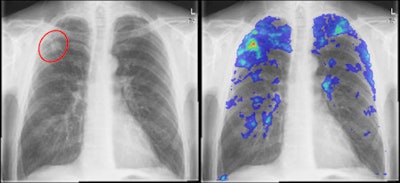 Left: Chest radiograph of a patient with culture-proven tuberculosis. A small lesion is visible in the right upper lobe. Right: CAD system output: highly suspicious locations are marked in red, while other less-suspicious areas are indicated in blue. All images courtesy of Dr. Laurens Hogeweg.
Left: Chest radiograph of a patient with culture-proven tuberculosis. A small lesion is visible in the right upper lobe. Right: CAD system output: highly suspicious locations are marked in red, while other less-suspicious areas are indicated in blue. All images courtesy of Dr. Laurens Hogeweg.Hogeweg noted that interest in using chest radiographs in TB screening algorithms is on the rise; especially as digital radiography removes many of the drawbacks associated with conventional x-ray such as the use of film and chemicals. Digital chest x-rays provide a quick, inexpensive test for TB and recent research studies have demonstrated good performance, he said.
Other TB testing methods suffer from limiting factors. Sputum cell culture is slow and costly, while sputum smear is insensitive, Hogeweg said.
However, TB screening with chest x-rays can also be problematic in a screening setting. TB signs on chest x-rays are difficult to interpret, leading to high interobserver variability. In addition, large numbers of chest x-rays have to be interpreted, generating high costs to employ readers, Hogeweg said.
Enter CAD
However, CAD might be able to help, serving as a prescreening, triage method for reducing the cost of TB screening algorithms. Since the software yields high sensitivity, it could be useful for performing triage of cases when used as a first reader. Cases found to be normal on CAD would be removed from the screening process, while abnormal studies would then be read by a human expert, Hogeweg said.
To test this hypothesis, the researchers sought to assess the performance of a research prototype CAD system (being jointly developed by the university's Diagnostic Image Analysis Group and Delft Imaging Systems) for detecting TB on chest radiographs in a high-risk screening setting. They also wanted to evaluate its potential as a triage tool.
The Find & Treat organization in the U.K. has been running a mobile screening program using digital x-rays to find TB cases in London, which has the highest TB rate among western European capitals, and a particularly high incidence among the homeless population, Hogeweg said. Between 2005 and 2010, the program acquired 47,510 digital chest exams from 38,717 individuals.
The research team identified 120 confirmed pulmonary TB cases in the Find & Treat database, and also gathered an additional set of 184 digital chest radiographs from the database to assess the CAD system's ability to distinguish between TB and non-TB cases. The radiographs were performed on a DigitalDiagnost system (Philips Healthcare).
The CAD software was originally developed for analysis of chest x-rays from high-TB-burden countries in sub-Saharan southern Africa, and was retrained for this study using a training set of 89 images that included all 20 culture-proven TB cases, and 69 consecutive normal cases from 2006.
It was trained using example of pixels in normal and abnormal regions, with moments of Gaussian derivatives extracted for each region. A classifier is then used to assign a score to each pixel, and each image receives one overall CAD score based on the 95% percentile of all of the pixel abnormality scores, Hogeweg said.
After the system was trained, researchers then tested its performance in the remaining 95 cases, which included all 28 culture-proven TB cases and 67 consecutive non-TB cases from 2009.
The system's performance was measured using receiver operating characteristic (ROC) analysis, which compared the CAD score with the reference standard. They also evaluated its potential as a triage tool by determining specificity when the software used a sensitivity of 95%.
The system yielded an overall area under the ROC curve of 0.86 in the test cases.
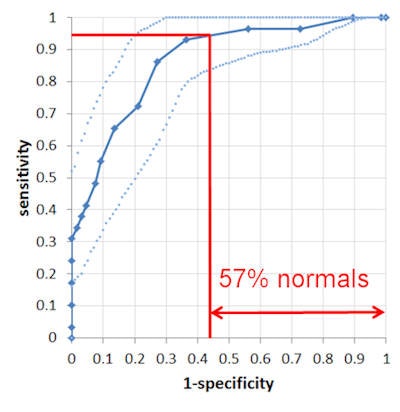 ROC curve from this preliminary study shows the potential for reducing the number of images that have to be read in a large screening program. This can be achieved by removing studies considered as normal by CAD while retaining high sensitivity for TB cases (indicated by the red lines).
ROC curve from this preliminary study shows the potential for reducing the number of images that have to be read in a large screening program. This can be achieved by removing studies considered as normal by CAD while retaining high sensitivity for TB cases (indicated by the red lines).Looking specifically at performance with 95% sensitivity, the CAD software yielded 57% specificity.
"This means that in a triage setting, we can actually discard 57% of the normal images," Hogeweg said. "This also means that in a screening setting where the majority of the images are normal, we can remove a large number of images from the screening process."
In future work, the team is aiming to improve the CAD algorithm and evaluate the system on the full Find & Treat database, Hogeweg said. They would also like to perform reader and cost-effectiveness studies.




